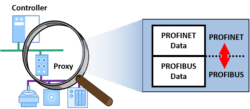Migrating from a Fieldbus or other industrial Ethernet to PROFINET is a common challenge. Every automation system is specialized in some way, and specialized components may not “speak” PROFINET. To move data from the specialized systems up to the PROFINET network, you have to add an interpreter to the network: A Proxy or a Gateway. Learn about their specific characteristics and functions:
Gateways
Gateways move I/O data between protocols, but may not transmit “special features” from one protocol to another. For example, a PROFINET to IO-Link Master gateway may map data from its slaves up to slots and subslots in the PROFINET device, but it won’t be able to provide diagnostic data about the connected slaves. In addition, each gateway’s “data mapping” must be configured for each individual gateway in a vendor-specific format. There is also a loss of data. For instance, some protocols don’t pass all the alarm data, very important for diagnostics and troubleshooting.
Proxies
Proxies fulfill the same role as Gateways: they translate a foreign network protocol to PROFINET. The biggest difference between the two is that proxies use standardized data mapping defined by PROFIBUS & PROFINET International (PI). By using a standard data map, a proxy produces a nearly invisible transition between PROFINET and the foreign protocol. It not only maps I/O data, but also alarms, diagnostics, and even network topology and health. Each proxy will implement the full data map defined by PI. PROFINET Proxies are defined for the following protocols:
 CC-Link
CC-Link- PROFIBUS DP
- PROFIBUS PA
- HART
- INTERBUS
- DEVICENET
- Foundation Fieldbus
- CANopen
- Modbus
- IO-Link
- AS-i
For example, IO-Link and AS-i proxies allow communication with smart devices without an Ethernet port. Because the data mapping in a proxy relies on a standard, there is no specified solution for some protocols. For those protocols, engineers have to rely on Gateway solutions to move data from PROFINET to other protocols.
Note: Full article from PROFINETuniversity.com by the PROFI Interface Center available HERE.
-Nelly Ayllon
